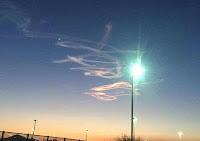Asteroid 2004 KH17 passed by the Earth at a distance of 16 990 000 km
(30.2 times the average distance between the Earth and the Moon, or 11.4% of the average distance between the Earth and the Sun), slightly before 0.20 am GMT on Thursday 2 June 2016. There was no danger of
the asteroid hitting us, though had it done so it would have presented a
considerable threat. 2004 KH17 has an estimated equivalent
diameter of 78-250 m (i.e. a spherical body with the same mass would be 78-250 m in diameter), and an towards the upper end of this range
would pass through the atmosphere and directly impact the ground with a
force of about 600 megatons (about 35 000 times the
explosive energy of
the Hiroshima bomb), causing devastation over a wide area and creating a
crater about 3.8 km across, and resulting in global climatic problems
that
could last for decades or even centuries.
The calculated orbit of 2004 KH17. JPL Small Body Database.
2004 KH17 was discovered on 29 May 2004 by the Massachusetts Institute of Technology's Lincoln Near Earth Asteroid Research Laboratory in Socorro, New Mexico.
The designation 2004 KH17 implies that it was the 433rd asteroid
(asteroid H17) discovered in the second half of May 2004 (period 2004 K).
2004 KH17 has a 219 day orbital period, with an elliptical orbit tilted at an angle of 22.1° to the plain of the Solar System which takes in to 0.36 AU from the Sun (36% of the distance at which the Earth orbits the Sun and considerably inside the orbit of the planet Mercury) and out to 1.07 AU (7% further away from the Sun than the Earth). This means that close encounters between the asteroid and Earth are fairly common, with the last thought to have happened in June 2013 and the next predicted in May 2019. Although it does cross the Earth's orbit and is briefly further from the Sun on each cycle, 2004 KH17 spends most of its time closer to the Sun than we are, and is therefore classified as an Aten Group Asteroid. As an asteroid possibly larger than 150 m in diameter that occasionally comes within 0.05 AU of the Earth, 2004 KH17 is also classified as a Potentially Hazardous Asteroid.
2004 KH17 also
has frequent close encounters with the planets Mercury (which it last had a close encounter with in November 1999 and is predicted to pass next in October 2061) and
Venus (which it last came close to in December 2006 and is predicted to pass close to again in October 2032). Asteroids
which make close passes to multiple planets are considered to be in
unstable orbits, and are often eventually knocked out of these orbits by
these encounters, either being knocked onto a new, more stable orbit,
dropped into the Sun, knocked out of the Solar System or occasionally
colliding with a planet.
See also...
 Fireball over Arizona. The American Meteor Society has
received reports of a bright fireball meteor being seen over much of
the southwest United States at about 4.00 am local time on Thursday 2
June 2016 (about 11.00 am GMT).
The fireball was seen across Arizona, Utah, New...
Fireball over Arizona. The American Meteor Society has
received reports of a bright fireball meteor being seen over much of
the southwest United States at about 4.00 am local time on Thursday 2
June 2016 (about 11.00 am GMT).
The fireball was seen across Arizona, Utah, New... Asteroid 2016 JD18 passes the Earth. Asteroid
2016 JD18 passed by the Earth at a distance of 625 300 km (1.63
times the average distance between the Earth and the Moon, or 0.42% of
the average distance between the Earth and the Sun), at about 11.25 pm
on Monday 16 May 2016. There...
Asteroid 2016 JD18 passes the Earth. Asteroid
2016 JD18 passed by the Earth at a distance of 625 300 km (1.63
times the average distance between the Earth and the Moon, or 0.42% of
the average distance between the Earth and the Sun), at about 11.25 pm
on Monday 16 May 2016. There... Asteroid 2016 JC6 passes the Earth. Asteroid 2016 JC6 passed by the Earth at a distance of 4 922 000 km
(12.8 times the average distance between the Earth and the Moon, or
3.29% of the average distance between the Earth and the Sun), at about 4.25 pm GMT on Sunday 8 May 2016...
Asteroid 2016 JC6 passes the Earth. Asteroid 2016 JC6 passed by the Earth at a distance of 4 922 000 km
(12.8 times the average distance between the Earth and the Moon, or
3.29% of the average distance between the Earth and the Sun), at about 4.25 pm GMT on Sunday 8 May 2016...
Follow Sciency Thoughts on Facebook.

